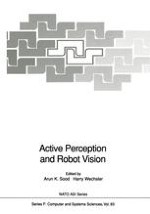1992 | OriginalPaper | Buchkapitel
A New Paradigm for Computational Stereo
verfasst von : Kurt Skifstad, Ramesh Jain
Erschienen in: Active Perception and Robot Vision
Verlag: Springer Berlin Heidelberg
Enthalten in: Professional Book Archive
Aktivieren Sie unsere intelligente Suche, um passende Fachinhalte oder Patente zu finden.
Wählen Sie Textabschnitte aus um mit Künstlicher Intelligenz passenden Patente zu finden. powered by
Markieren Sie Textabschnitte, um KI-gestützt weitere passende Inhalte zu finden. powered by
Most research in computational stereo has followed the approach described in Barnard and Fischler’s “Computational Stereo” (in Computing Surveys‚ vol. 14, no. 4, 1982). This approach, although conceptually appealing and theoretically elegant, suffers from several limitations. Among these are the difficulties in the matching process, problems with feature localization, restrictive camera geometries, and, perhaps most importantly, the extensive computational effort required to produce depth estimates. By approaching the problem from more of an engineering perspective, a new paradigm for computational stereo had been developed that avoids the problems inherent in the conventional “extract and match” paradigm. The Intensity Gradient Analysis (IGA) technique determines depth values by analyzing temporal intensity gradients arising from the optic flow field induced by known camera motion. IGA assumes nothing about the nature of the environment and places no restrictions on camera orientation (IGA is applicable to sequences obtained using arbitrary translational motion).
